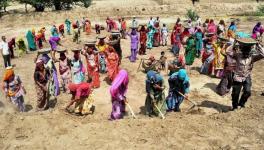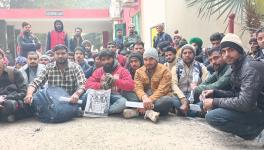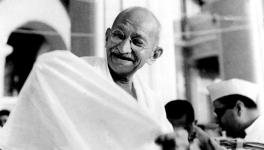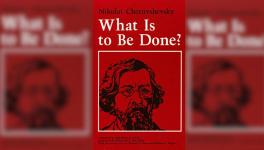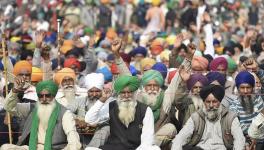‘Working People Will Make a Better World’
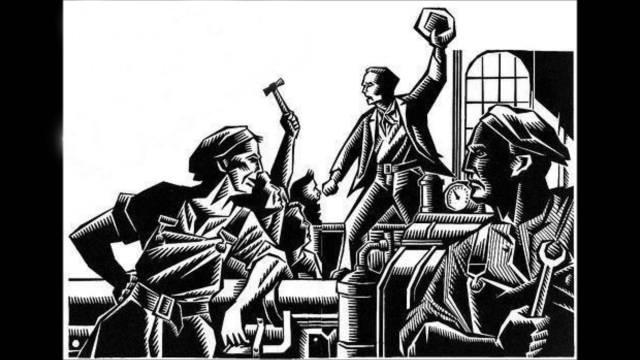
Image Courtesy: Anarkismo.Net
Priscilla Murolo is a professor of history at Sarah Lawrence College, where she formerly directed the graduate programme in women’s history. She also teaches in the Union Leadership and Activism Master’s Program at the University of Massachusetts. Beginning in the1960s, she has been involved in the women’s movement, labour organising and many community campaigns and organisations. She is the co-author with A.B. Chitty of From the Folks Who Brought You the Weekend: An Illustrated History of Labor in the United States, with illustrations by Joe Sacco. Murolo also writes for a variety of publications including Radical History Review, Labor Notes and Women’s Review of Books and blogs at priscillamurolo.net Edited excerpts:
Piascik: Can you talk about your background?
Murolo: I grew up in Connecticut, mostly in Wolcott. One of my parents was usually in school, first my dad, who went to college and later to law school on the GI Bill, and then my mom who became a high-school math teacher. They were both working-class kids—emphasis on “kids” because they were 19 and 23 when I, the oldest of three, was born and, when it came to taking responsibility for family life, both were late bloomers. They weren’t labour people, though my mom belonged to the National Education Association. They divorced when I was 19, by which time I was pretty much on my own.
You came of age during the excitement and tumult of the 1960s. What were you doing at the time and how did it influence you?
I went to college in 1966, to Barnard in New York City, but I stayed there just a year before I dropped out. While I was there, I became active in the anti-war movement, but I wasn’t an organiser in the sense that I strategised. That happened later on, in increments. First, I was working at Columbia University’s math library just as Local 1199’s drive to unionise Columbia’s libraries was going public in the winter of 1968-69, and I got involved in that.
The next year, I was living in North Carolina and joined a women’s liberation group. North Carolina’s Left was entirely different from New York City’s. In New York, there were so many leftists that all sorts of groups could flourish to the point where they imagined they’d someday take over the world. In that atmosphere, sectarianism ran rampant. Not so in North Carolina, where leftists were so outnumbered and outgunned, both literally and figuratively, that different groups tended to make common cause whenever they got the chance to do so.
Through my women’s group, I worked on all sorts of causes: welfare rights, Black communities’ access to medical care, worker organizing, the war in Vietnam...you name it. Then, in 1971, I moved to the Bronx, got involved in various kinds of community organising such as tenant issues, unemployed workers’ rights and strike support, to name just a few. Because I worked in office jobs in Manhattan, I also joined a group of clerical workers, Office Workers United, that advocated for unionism in white-collar workplaces like insurance companies and publishing houses. This is how I learned to think strategically, which is another way of saying I learned how to be not just an activist but also an organiser.
What led to your interest in history and why labour history specifically?
I thoroughly disliked reading history until the early 1970s, when I discovered labour history and African American history, neither of which got any coverage in my history classes in high school. I had no political critique of “great man” history; all I knew was that it bored me. Then, in the Bronx, I took part in a community organisation that, among other things, ran a little bookstore on 183rdStreet, and I started reading the books on sale there, mostly African American history.
The one I remember most vividly is To Be A Slave, a collection of excerpts from slave narratives that was edited by Julius Lester. I loved that book. Now I realise that I was experiencing the excitement of reading primary documents for the first time. All I knew then was that the book offered first-person stories that were astonishing, infuriating, saddening, and inspiring all at the same time. This is how I discovered that history didn’t have to be boring.
About a year into this reading project, an older woman involved in Office Workers United steered me toward labour history, in particular Labor’s Untold Story by Richard Boyer and Herbert Morais. I read it again and again. So, when I went back to college in my late twenties, I gravitated toward courses in history, and by the time I was finished, I wanted to be a historian. Going to graduate school at Yale, where David Montgomery had recently joined the faculty, made it possible to concentrate in labour history under the guidance of a world-class mentor.
There were important changes in history scholarship in the 1960s and 1970s such as “history from the bottom up” and “people’s history.” What influence if any did these efforts have on you and how do you assess them?
I first encountered “history from the bottom up” and “people’s history” through the books I found at that little store on 183rdStreet, through Labor’s Untold Story, and through the stuff I picked up at random at radical bookstores in Manhattan, especially the Communist Party’s Jefferson Books and the Maoist-oriented China Books and Periodicals.
My tendency as a labour historian has always been to look at life beyond the workplace as well as on the job, and I’d say that derives first and foremost from experience. Life taught me that working people are multi-dimensional. They care about many things in addition to work and unions, and they bring multiple concerns and aspirations to any movement they get involved with. For some women, for example, getting active in a union can be a way of getting out from under the thumb of your husband as well as getting a fair share at work. That was certainly true for me when I joined 1199.
Later on, in the Bronx, I worked with a group of unemployed youth; we’d leaflet and petition and pull guerrilla actions to get quick justice for people who were coming to the unemployment office on Jerome Avenue and 168th Street, where we set up shop on the sidewalk out in front. The other people involved in that project made a profound impression on me and still, more than 40 years later, influence the way I think about working people. For instance, there was a guy named Sonny who was a pretty tough kung fu fighter but also an extraordinarily patient, tender teacher of kung fu for children in his neighborhood. Another person, Shirley, was an avid feminist; she carried around a spiral notebook in which she’d write down her thoughts on the subject, including all of the lyrics to Helen Reddy’s song “I Am Woman,” which Shirley loved.
Another lesson that I still vividly remember took place under the auspices of Office Workers United. Those of us who worked in midtown Manhattan got the local YWCA to supply free meeting rooms and every few weeks we’d leaflet to try to get office workers out to a lunchtime meeting about organising at work. Very few people showed up. Then one time, about a year into this effort, we leafletted for a meeting about organising an office workers contingent in an upcoming anti-war march. That was our only meeting that got a good turnout, and we did in fact muster a contingent for the march.
The lesson seemed clear to me. That few people came to talk about unionism didn’t mean they thought the status quo was hunky dory; it was that they had other things on their minds, among them the war in Vietnam. These and similar experiences go a long way to explain why From the Folks Who Brought You the Weekend addresses subjects beyond labour history’s usual parameters.
The multi-dimensional nature of working class life is definitely a rich feature of From the Folks Who Brought You the Weekend. Is there an example or two from the book that make that point especially well?
One prime example that springs to mind is the way the book addresses the era we commonly call “the sixties.” Historians of the American sixties—which actually began in the mid-1950s and extended into the late 1970s—typically overlook or underplay the fact that workers took part in the liberation movements that sprang up in that era. Like-wise the fact that many of the radical youth exceptionally active in those movements were children of the working class.
In From the Folks, the chapter on sixties movements places workers and their children at centre stage; and, really, that’s not hard to do because they were actually there. Rosa Parks was an experienced civil rights organiser and a department store seamstress; E.D. Nixon was her fellow leader of the local NAACP in Montgomery and an officer of the Brotherhood of Sleeping Car Porters; Fannie Lou Hamer was a guiding light of the Mississippi Freedom Democratic Party and a third-generation sharecropper who got evicted from her home when she became active in the movement for voting rights; Bobby Seale was the founding chairman of the Black Panther Party and the son of a carpenter who had moved his family from Texas to Oakland, California, during World War II.
I could continue in this vein for another hour because much the same pattern prevailed in the Chicano movement, the Puerto Rican movement, the Asian American movement, the Native American movement, and the welfare rights movement along with large parts of the antiwar movement, the women’s movement, the queer movement, and the vanguard of the movement among people with disabilities. And it’s not just that working-class individuals played prominent roles in liberation movements; it’s also that grassroots activism surged in working-class communities, which mobilised around issues including tenants’ rights, healthcare, community control of schools, environmental pollution, and police brutality.
Sixties’ consciousness and causes penetrated the labuor movement, too. The Black freedom struggle inspired a giant wave of union organising among public employees and workers in semi-public institutions such as New York City’s voluntary hospitals. Chicano nationalism fueled the rise of the United Farm Workers. Women asserted their rights in uprisings like the Farah strike of 1972-1974, in which 4,000 Mexican American women struck for union recognition and won the support of a national coalition of unionists, Chicano nationalists, radical students, men and women religious, and others….
My own experience made me especially determined to challenge American historians’ conventional wisdom about the sixties; I knew at a gut level that stereotypes casting workers as enemies of sixties’ movements are simplistic to say the least. But you can scratch the surface of any period in labour history and find complexities like those I’ve just outlined.
In the decades that preceded the Civil War, the labour movement spawned not only unions and the first central labour councils but also workers’ political parties, workers’ cooperatives, and a massive self-help movement that promoted abstinence from alcohol. In the 1880s workers came together in the Knights of Labor not only to fight for fair wages and the eight-hour day but also to sing songs, write poetry, attend picnics and parties, and discuss the importance of kindergartens and currency reform.
During the labour upheavals of the 1930s, victories in the workplace inspired thoughts about remaking the rest of the world. Len De Caux, editor of the CIO News, put it this way: “Now we’re a movement, many workers asked, why can’t we move on to more and more? . . . Why can’t we go on to create a new society with workers on top, to end age-old injustices, to banish poverty and war.”
This is why the multi-dimensional nature of working class life looms so large in From the Folks.
Another outstanding feature of the book is the ongoing tension between wonderful episodes of multiracial working class unity and other instances where the white supremacist nature of the society infected white workers and resulted in disunity while fueling the oppression of people of colour. Is this going to be an ongoing problem until enough white workers confront white supremacy head on?
This has always been a monumental issue for the American labour movement, and the long history of how white supremacy has played out there in terms of exclusion, division, betrayal and violence is just plain depressing. Still, I think we can draw useful lessons from this history, especially the moments of multiracial solidarity but also the moments when the same old same old has prevailed.
One important lesson on the latter front is that race itself—the assignment of people to different categories based on their ancestry and physical appearance—is both very powerful and very fragile. It’s powerful enough to have served as a central, often the central, organisational principle of American society ever since the late 1600s, when colonial law simultaneously institutionalized chattel slavery and racial categories. At the same time, it’s so fragile that it must be constantly re-invented and re-asserted through party politics, which routinely call on working people to support this or that group of elites on the basis of racial policies, not class interests. This has been going on ever since the late 1820s, when the Democratic Party established itself as the voice of both white workingmen and slaveholders by offering them the common ground of white supremacy.
While the particulars have changed over the past 190 years, the basic structure has remained the same. The Roosevelt coalition of the 1930s-1940s included class-conscious workers of all colours, but the Democratic majorities in Congress depended on the presence of southern “Dixiecrats” who rejected racial equality and detested the CIO. Today, Donald Trump’s Republican Party presents itself as the mouthpiece of the “forgotten American”—presumably white, perhaps African American, but above all a native-born person threatened by immigrants. On the other side, we have the Democratic Party, whose insurgent progressives may yet win the day but whose regulars deploy a politics of race that merely mirrors Trump’s—whatever he’s for, we’re against—and here, too, class politics have no place. This situation poses immense challenges for a labour movement that may not be strong enough to take on the Democratic establishment, let alone inclined to do so.
But history suggests that we might be mistaken to zero in on party politics as we try to figure out what the labour movement can do to counteract the Trump phenomenon. The moments when white workers have managed to transcend white supremacy -- when class solidarity has overshadowed racial divisions -- have invariably arrived when the labour movement was gaining ground in workplaces. Extrapolating from this fact, I’d say that the most important thing unions can do to promote working-class unity is to win on the job. And by this I don’t mean that the union wins by acquiring more dues-paying members; I mean that the workers win by seeing how much they can accomplish through collective action.
To bring all of this back to your question, I don’t think history supports the idea that white workers need to grapple with all of the pernicious implications of white supremacy before they join with workers of colour to build working class solidarity. Instead, I think history offers multiple examples of white workers’ overcoming white supremacy in the process of struggling side by side with workers of colour….
You document the similar dynamic where men and women workers sometimes struggled in common cause and others where male workers opposed women’s equality.
On this front, I think it’s especially important to consider connections between what happens on the job and what happens at home. To illustrate the point, I’ll share a story told to me by Francine Moccio, author of Live Wire -- a wonderful book about women in the construction division of the International Brotherhood of Electrical Workers in New York City, IBEW Local 3. Some years ago, Francine told me a story that I don’t think made it into her book, and here it is: Like most electricians in the IBEW, members of Local 3’s construction division attend the “topping out” ceremony that the Ironworkers hold once they’ve finished a building’s frame and the electricians have wired the elevator that workers will use to construct the rest of the building. They put a fir tree and an American flag on top of the frame and throw a little party, which the workers’ families often attend. One time Francine went to a topping out party on a jobsite where Local 3 had a woman working, and when her union brothers’ wives saw her, they were shocked and kind of angry.
Talking with them, Francine found that they weren’t afraid their men were going to engage in sexual hijinks with this woman. What bothered them, rather, was that their husbands expected to be waited on when they came home from work…. But at the topping out party, the wives were seeing that, actually, a woman can do what a male electrician does. So why couldn’t the men wash a dish or change a diaper or run a vacuum cleaner now and then? As this story suggests, workingmen’s opposition to women’s equality in the workplace may have less to do with the workplace than with home life….
Socialism and labour have historically been closely linked, yet today we find ourselves in a period where socialism is rapidly rising in popularity while organised labour is in catastrophic decline. Do you see ways in this new period where labour can be invigorated by socialism and socialists?
Had you asked me this six months ago, I might have dithered; but here’s what happened this past July when I taught a seminar at UMass’s master’s programme in union leadership and activism: for the very first time since I began teaching labor history in the programme in 2005, my students -- all of them labour movement staffers or rank-and-file activists --asked me to stay late one day to talk about the history of socialism. Bottom line: the young people in labour movement jobs have already cast their lot with socialism. We oldsters need to get with it, sharing our knowledge, our questions, our hopes…
From the Folks Who Brought You the Weekend is incredibly comprehensive; is there any one thing you would like readers to take away after reading it?
Here’s what I most want readers to take away from the book: The labour movement may be down, but it’s never down for the count. Every day for more than 400 years, working people have been devising new ways to defend themselves against indignity, deprivation and injustice. When one line of defence fails, another takes its place, and since collective strategies are invariably the most effective for the most people, the arc bends in that direction. This is the main lesson of labour history, and since the past is the best predictor of the future, there is every reason to believe that working people will make a better world.
Andy Piascik is a long-time activist and award-winning writer whose most recent book is the novel In Motion. He can be reached at [email protected].
Courtesy Andy Piascik and Zcomm.org
Get the latest reports & analysis with people's perspective on Protests, movements & deep analytical videos, discussions of the current affairs in your Telegram app. Subscribe to NewsClick's Telegram channel & get Real-Time updates on stories, as they get published on our website.












